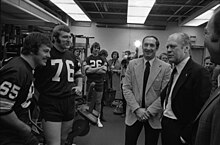
The Green Bay Packers Hall of Fame is a team-specific hall of fame honoring players, coaches, executives and other contributors to the history and success of the Green Bay Packers, an American football team in the National Football League (NFL). It was the first hall of fame built to honor a single professional American football team. John P. Holloway, a Brown County administrator and arena director, and William Brault, a Green Bay restaurateur and Packers fan, co-founded the Packer Hall of Fame museum in 1966. According to them, they got the idea after visitors to Green Bay would repeatedly ask about the Packers' storied history. Sensing opportunity, they went to Packers head coach Vince Lombardi, suggesting a hall of fame should be made to attract and educate tourists about the Packers and their history. Lombardi gave them his approval, and according to Brault, as he left his office, Lombardi called out to him, "Don't screw it up!"

Mark Hodge Murphy is an American football executive and former player who is the president and chief executive officer (CEO) for the Green Bay Packers of the National Football League (NFL). Murphy, a safety, went undrafted in the 1977 NFL Draft after playing college football at Colgate University. He was signed by the Washington Redskins, where he played for eight seasons from 1977 to 1984. With the Redskins, Murphy won Super Bowl XVII, played in another Super Bowl and led the NFL in interceptions in 1983, the year he was named to his only Pro Bowl and received his only First Team All-Pro honor. During his last few years in the NFL he received a Master of Business Administration from American University and then, after his career ended in 1984, a Juris Doctor degree from Georgetown University in 1988. After his playing career, he worked for the NFL Players Association (NFLPA) and then as a trial lawyer for the United States Department of Justice. In 1992, he was hired as the athletic director of his alma mater Colgate University. In 2003, he moved to Northwestern University to serve as their athletic director, a position he held until 2007.
Robert Ernest Harlan is an American former football executive who served as the president of the Green Bay Packers for 19 years. Harlan also held the titles of chairman of the board and chief executive officer for the Packers. He was a graduate of Marquette University, where he later served as the Sports Information Director for six years. After his tenure at Marquette, Harlan worked for the St. Louis Cardinals baseball team for five years in community and public relations. In 1971, he was hired by the Packers as assistant general manager. For the next 18 years, Harlan worked in different positions in the front office for the Packers before being promoted to executive vice president in 1988. In 1989, after the retirement of Robert J. Parins, Harlan was elected as the Packers' ninth president, a position he held until 2008. Harlan became the first team president whose background was primarily in football; all previous presidents of the Packers were local civic leaders or businessmen in the Green Bay, Wisconsin-area.

Gerald Francis Clifford was an American trial lawyer, politician, and executive officer of the Green Bay Packers. Clifford began his legal career in 1913 after studying law at the University of Michigan. He was an active trial lawyer, specializing in cases regarding search and seizure and Prohibition. He once served as assistant Attorney General of Wisconsin where he became well-known for prosecuting corruption cases. Politically, Clifford was a leader in the Democratic Party of Wisconsin and was once a Wisconsin Democratic nominee for Congress in 1934. In addition to his work in law and politics, he also served as an executive officer and team lawyer for the Green Bay Packers. Clifford assisted the organization in avoiding bankruptcy, reincorporated the team under a new ownership model, and helped prevent the team from moving away from Green Bay, Wisconsin. He is one of The Hungry Five, a group of businessman who were instrumental in the early development of the Packers. Clifford died on February 24, 1952, at the age of 62. In recognition of his contributions, he was elected to the Green Bay Packers Hall of Fame in 1991.

Robert Mann was an American professional football player in the National Football League (NFL). A native of New Bern, North Carolina, Mann played college football for the Hampton Pirates in 1942 and 1943 and the Michigan Wolverines in 1944, 1946 and 1947. Playing the end position, he broke the Big Ten Conference record for receiving yards in 1946 and 1947. After not being selected in the 1948 NFL Draft, Mann signed his first professional football contract with the Detroit Lions, where he stayed for two seasons. He later played for the Green Bay Packers for parts of five seasons until 1954. Mann broke the color barrier for both teams.

Dominic John Olejniczak was an American real estate broker, politician, and football executive. Olejniczak served as an alderman of Green Bay, Wisconsin, from 1936 to 1944. He was then elected mayor, serving for 10 years from 1945 to 1955. During his tenure as mayor, a number of large infrastructure projects were completed and city administration was streamlined. Olejniczak was also known for his work with the Green Bay Packers. Over a period of almost 40 years, Olejniczak served as a member of the board of directors, a vice president, president, and chairman of the board. His 24 years as president is the longest tenure of any Packers president. During his presidency, he hired Vince Lombardi in 1959, the Packers won five championships, and the team saw its net worth grow over 5,000%. In recognition of his contributions, Olejniczak was inducted into the Green Bay Packers Hall of Fame in 1979 and the National Polish-American Sports Hall of Fame in 2020. He died in 1989, after a series of strokes.
Mark Steven Murphy is an American former professional football player who was a safety for the Green Bay Packers of the National Football League (NFL). After graduating from GlenOak High School near his hometown of Canton, Ohio, Murphy attended West Liberty State College. At West Liberty, he played college football for all four years, with the last three as a starter for the Hilltoppers. In his senior year, he was named All-WVIAC and won the WVIAC championship. He went undrafted in the 1980 NFL Draft, but was subsequently signed by the Green Bay Packers as an undrafted free agent. He played for the Packers for 12 years before retiring in 1991. After his playing career, Murphy coached high school and college football in Ohio. He was elected to the Green Bay Packers Hall of Fame in 1998 in recognition of his contributions to the team.
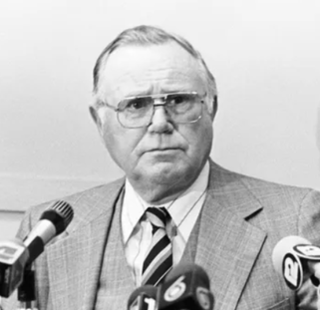
Robert James Parins was an American judge and football executive. Parins was born and raised in Green Bay, Wisconsin, and went on to receive a law degree from the University of Wisconsin Law School in 1942. He served as the Brown County, Wisconsin, district attorney from 1949 to 1950 and as a circuit court judge for the county from 1968 to 1982. In the early 1990s, Parins played a notable role in a case related to Jeffrey Dahmer, an American serial killer. Outside of his legal career, Parins served in various leadership positions for the Green Bay Packers, including serving on the board of directors. In 1982, he was elected president of the Green Bay Packers, serving as the first full-time president in team history. In recognition of his accomplishments, which included the formation of the Green Bay Packers Foundation, financial improvements and facility expansion, Parins was inducted into the Green Bay Packers Hall of Fame in 1998. Parins died in 2017 at the age of 98.
Wuert Engelmann was an American professional football player who played back for four seasons for the Green Bay Packers. He played college football at South Dakota State University before playing professional football. After his career, he worked for 36 years for the Northern Paper Mill.
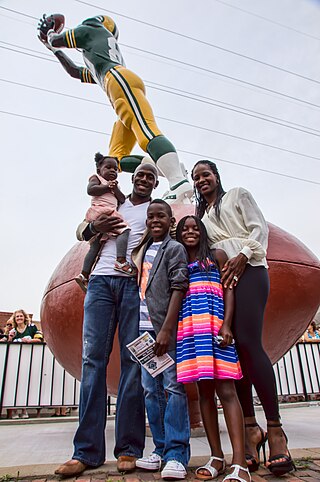
The Receiver statue is a 22-foot (6.7 m) tall public statue in Green Bay, Wisconsin associated with the Green Bay Packers football team. Originally located outside the Green Bay Packers Hall of Fame, the statue was dedicated to the "great past, present and future enshrinees in the Green Bay Packers Hall of Fame" on June 8, 1985. The player on the statue had number 88 on his jersey and the name listed on the back jersey was "PACKER." The statue was sold in 2003 to Titletown Brewing and was moved to the corner of Dousman Street and Donald Driver Way in front of the old Chicago and North Western Railway Passenger Depot. It was re-dedicated in the likeness of Donald Driver on June 15, 2013.

Andrew Blair Turnbull, was a businessman and American football executive. Turnbull founded and owned the Green Bay Press-Gazette and was the first president of the Green Bay Football Corporation (now called Green Bay Packers, Inc., the non-profit organization that owns the Green Bay Packers. He served as publisher, general manager, and business manager of the Press-Gazette for 45 years. During the early years of the Green Bay Packers, Turnbull helped convert the team from a privately held franchise to a publicly owned, non-profit corporation. He also helped the team through multiple financially challenging periods, which saw him identified as part of The Hungry Five, a group of early Packers supporters. Between 1923 and 1928, he served as the first president of the Green Bay Football Corporation and remained on the corporation's board of directors and executive committee until 1949. Turnbull died in 1960 and was elected to the Green Bay Packers Hall of Fame in 1977.

Lee Joannes, born Joseph Leland Heath Joannes and also known as Leland Joannes, was a businessman and American football executive. Joannes owned Joannes Brothers Company, a wholesale grocery store, and was the fourth president of the Green Bay Football Corporation, which became Green Bay Packers, Inc. during his tenure. He was part of The Hungry Five, a group of businessmen who are credited with keeping the Green Bay Packers in operation during numerous financially difficult times. He served on the Packers board of directors for over 58 years in various roles, including chairman, president, vice president, secretary, treasurer, and director emeritus. During his 17 years as president from 1930 to 1947, the Packers won five NFL Championships while enduring the Great Depression and World War II. In recognition of his contributions, he was elected to the Green Bay Packers Hall of Fame in 1981. Joannes died in 1982 at the age of 89.

Raymond E. Evrard was an attorney and the second president of the Green Bay Football Corporation, the non-profit organization that owns the Green Bay Packers (now known as Green Bay Packers, Inc. In addition to his role as Packers president for one year, Evrard also served on the Packers board of directors and was the team's lawyer until 1929. Evrard was also elected for three terms as district attorney of Brown County, Wisconsin, serving from 1922 to 1929. He continued practicing law until the 1970s. Evrard played an important, yet often overlooked role in helping to organize the Packers during the team's early years through his various leadership roles. Evrard died on March 21, 1974.

W. Webber Kelly, born William Webber Kelly, was a prominent medical doctor in the state of Wisconsin known for being the third president of the Green Bay Packers|Green Bay Football Corporation, the non-profit organization that owns the Green Bay Packers. Kelly was a practicing physician in Green Bay, Wisconsin, for almost 50 years and a respected civic leader. During his one year as president of the Packers for the 1929 season, the team went 12–0–1 and won its first NFL Championship. Kelly was identified as part of The Hungry Five, a group of Green Bay businessmen who were instrumental in guiding the Packers through multiple financially challenging periods. In addition to his presidency, Kelly served as the team physician from 1921 to 1943 and as a member of the Packers' board of directors from 1923 to 1949. After a falling out with Packers co-founder, head coach, and general manager Curly Lambeau, Kelly resigned from the Board in 1949. Two years later he died of a heart attack at the age of 75. In recognition of his contributions, Kelly was inducted into the Green Bay Packers Hall of Fame in 1994.

Emil Richard Fischer was an American businessman and a football executive for the Green Bay Packers. Fischer was well known in the Green Bay cheese industry, a nationally recognized businessman, and a local civic leader. From 1948 to 1952, he served as the fifth president of the Packers. He is credited with leading the Packers through one of the most difficult periods in the team's history. During his tenure, the team's co-founder and longtime coach Curly Lambeau resigned, the Packers issued their third stock sale, and the National Football League (NFL) merged with the All-America Football Conference (AAFC). He also sat on the organization's board of directors and executive committee from 1935 to 1958. After his presidency ended, he served as chairman of the board until his death in 1958. In recognition of his contributions to the team, Fischer was inducted into the Green Bay Packers Hall of Fame in 2013.
Carl Wallace "Bud" Jorgensen was an American athletic trainer for the Green Bay Packers in the National Football League (NFL). For over 46 years, Jorgensen worked in varying capacities as an athletic trainer, assistant trainer and property manager for the Packers. After his career with the Packers, he continued as college basketball athletic trainer for University of Wisconsin–Green Bay men's basketball. Jorgensen was recognized for his long career and was identified as an expert in the field of athletic training. He was inducted into the National Athletic Trainers Association Hall of Fame in 1968 and the Green Bay Packers Hall of Fame in 1976. Jorgensen died of undisclosed causes on December 18, 1982, at the age of 78.
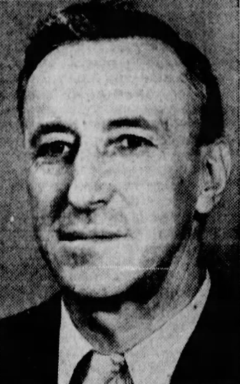
Frank John Jonet was an American accountant known for serving as the secretary-treasurer of the Green Bay Packers. Jonet graduated from State Teachers College in Wisconsin and taught for 14 years. Professionally, he was a trained accountant who worked for various businesses and was the treasurer for the city of Green Bay, Wisconsin. Associated with the Packers from his time with the Indian Packing Company in 1919 and 1920, Jonet would maintain some link with the team for the next 32 years. In 1933, Jonet was named the receiver for the Packers after the team experienced severe financial issues and entered bankruptcy. After reorganizing to Green Bay Packers, Inc. in 1935 and raising funds through a stock sale, the Packers were saved from folding as an organization. That year, Jonet was named the treasurer for the Packers. In 1941 his title was changed to secretary-treasurer and in 1947 he was elected to the team's board of directors, which he would serve on until his death in 1951. In 2011, Jonet was inducted into the Green Bay Packers Hall of Fame.
Albert Raymond Treml is an American former photographer and videographer who worked for the Green Bay Packers from 1967 to 2001. Treml, a Green Bay, Wisconsin native, was a lifelong Packers fan. After graduating from Green Bay Central Catholic High School, Treml attended Fort Monmouth's photography school while serving in the United States Army. He was stationed in France as a photographer from 1955 to 1959. After returning to Wisconsin, Treml worked for local newspapers and TV stations as a photographr and videographer before working part-time filming Packers games. After being hired by Vince Lombardi in 1967 as only the second full-time film director in the National Football League (NFL), Treml would go on to work for the Packers for 34 years before retiring in 2001. In recognition for his contributions to the team and to sports videography, Treml was inducted in he Green Bay Packers Hall of Fame and the College Sports Video Association Hall of Fame in 2008 and 2014, respectively.
Gerald Ralph Atkinson was an American businessman and football executive for the Green Bay Packers. Atkinson worked for H. C. Prange Co. in Green Bay, Wisconsin, in various capacities from 1947 to 1973. During this time, he became associated with the Packers. In 1949, he was asked to lead a campaign to help raise funds for the Packers, who had dire financial issues. This campaign, which included an intra-squad game on Thanksgiving Day, raised enough money to keep the Packers afloat. A year later he was elected to the Packers' board of directors, serving for 45 years until 1995. While on the board, he served an important role in helping advocate for Green Bay voters to authorize funding for New City Stadium, which was completed in 1957. Atkinson was inducted into the Green Bay Packers Hall of Fame in recognition to his contributions to the team. He died on October 8, 1996, at the age of 89.
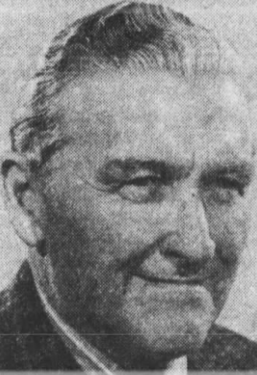
Wilner Edward Burke was American band director known for leading the Lumberjack Band, the team band for the Green Bay Packers. Burke, a native of Green Bay, Wisconsin, served as an alderman for the city for 21 years and served on the County Board. However, he became known for his relationship with the Packers. Starting in 1939, he was put in charge of the Packers team band, which he had been part of since the early 1920s. From 1940 to 1981, Burke served as the band director and also coordinated all halftime entertainment. The band, which changed its name to the Green Bay Packers Band, played across the state at parades and other special events. Burke retired prior to the 1982 NFL season and died three years later, at the age of 77.

